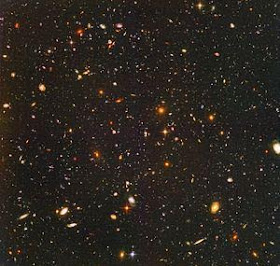Among other things, the article, by Sten Odenwald, explains that the Big Bang should not be thought of as an explosion of matter into a pre-existing space, since there was no pre-existing space.
Here are some excerpts from Odenwald's column:
The Big Bang wasn't really big. Nor was it really a bang. In fact, the event that created the universe and everything in it was a very different kind of phenomenon than most people -- or, at least, most non-physicists -- imagine.Odenwald writes that many people think of the Big Bang as a gigantic firework burst which radiates debris from a central point in a brilliant spray of light:
Even the name "Big Bang" originally was a put-down cooked up by a scientist who didn't like the concept when it was first put forth. He favored the idea that the universe had always existed in a much more dignified and fundamentally unchanging, steady state.
But the name stuck, and with it has come the completely wrong impression that the event was like an explosion.
That image leads many of us to imagine that the universe is expanding because the objects in it are being flung apart like fragments of a detonated bomb. That isn't true. The real reason that the universe is expanding is that the objects in it are staying in one place -- the same place they were when the Big Bang started -- and the space between them is growing.
In other words, space is not just void. It is a full-fledged player and is undergoing change. I know that sounds crazy, but it's true.
Our "fireworks" image of the phenomenon depends on five basic requirements: 1) A preexisting sky or space into which the fragments from the explosion are injected; 2) A preexisting time we can use to mark when the explosion happened; 3) Individual projectiles moving through space from a common center; 4) A definite moment when the explosion occurred; and 5) Something that started the Big Bang.They're rendered false or unnecessary by a proper understanding of Einstein's theory of General Relativity (GR), which Odenwald spends some time explaining. He then discusses why the "fireworks" image is misleading.
All of these requirements in our visualization of the Big Bang are false or unnecessary.
Preexisting Space? There was no preexisting space. The mathematics of GR state unambiguously that three-dimensional space was created at the Big Bang itself, at "Time Zero," along with everything else.Odenwald elaborates on each of these themes in more detail in the article. The next portion of his column assumes the truth of what philosophers call the B theory of space-time. This theory holds that all of space-time - past, present and future - exists now, somewhat like an entire movie exists simultaneously on a DVD.
Preexisting Time? Nor was there preexisting time. Again, GR's mathematics treats space and time together as one object called "space-time," which is indivisible. At Time Zero plus a moment, there was a well-defined quantity called time.
Individual objects moving away from a common center? There is no common center. Moreover, it is equally true to say every place in the universe is at the center. In other words, no matter where in the universe you might stand to gaze at the heavens, you would see all other galaxies racing away from you.
Moreover, galaxies don't move through space. Rather space is stretching like the surface of an inflating balloon. If we imagine buttons (representing galaxies) glued onto the balloon, the buttons will move apart from each other as the balloon expands:
Projectiles moving through space? If space is stretching like this, where do the brand new millions of cubic light years [of space] come from? The answer in GR is that they have always been there. Space has always existed in the complete shape of the universe in four dimensions.
But it is only as all four dimensions, including time, play out that the full shape and size of the universe is revealed.
It is only because of the way the human mind traditionally works that our consciousness insists on experiencing the universe one moment at a time.
Was there a definite moment to the start of the Big Bang? GR is perfectly happy to forecast that our universe emerged from something called a singularity, a point of infinite density that had no physical size at Time Zero. Any more than this, we cannot say.
 |
| The Hubble Deep Field: The points of light are not stars, they're all individual galaxies like the Milky Way |
Odenwald then approaches the most philosophically intriguing aspect of the Big Bang hypothesis:
Something started the Big Bang. At last we come to the most difficult issue in modern cosmology. In a real fireworks display, we can trace events leading to the explosion all the way back to chemists who created the gunpowder and wrapped the explosives. GR, however, can tell us nothing about the stages preceding the Big Bang.In other words, the universe appears to have arisen out of nothing (ex nihilo), at least nothing physical or material, pretty much as theologians have always insisted. There was nothing and abruptly there was an expanding space-time.
In fact, among GR's strongest statements is one saying that, before the singularity, time itself may not have existed.
Very weird. It's impossible for us to conceptualize how "something" could come from nothing. It's also "weird" how much this sounds like Genesis 1:1.
All of the above receives further elaboration from Odenwald at the link. He does a good job of making a very esoteric topic reasonably comprehensible.